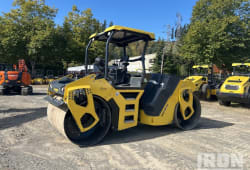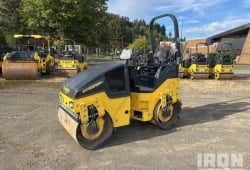Basics of Balancing Financing Costs and Profit Margins for Heavy Equipment
13 Lectura mínima
)
agosto 12, 2023
In today's competitive business landscape, heavy equipment plays a vital role in various industries such as construction, mining, and agriculture. However, acquiring and maintaining heavy equipment can be a costly endeavor, with significant financial implications. Balancing financing costs with profit margins is crucial for businesses operating in these industries to ensure long-term success and profitability. In this article, we will explore the basics of financing heavy equipment, analyze the impact of financing costs on profit margins, discuss strategies for balancing these costs, explore alternative financing options, and take a glimpse into future trends in heavy equipment financing.
Understanding the Basics of Financing Heavy Equipment
What is Equipment Financing?
Equipment financing is a financial arrangement that enables businesses to acquire the necessary equipment without fully paying for it upfront. Instead, the equipment is purchased through a lease or loan, allowing businesses to spread the cost over time while still benefiting from its use.
When a company decides to invest in heavy equipment, they are making a long-term commitment to their business. However, the high upfront cost of purchasing heavy equipment can be a significant barrier for many businesses, especially those in heavy industries.
Heavy industries, such as construction, mining, and manufacturing, heavily rely on specialized equipment to carry out their operations efficiently. These industries require heavy machinery, such as excavators, bulldozers, cranes, and loaders, to name a few. However, this equipment comes with a hefty price tag, which can strain a company's finances.
Importance of Equipment Financing in Heavy Industries
Equipment financing provides businesses in heavy industries the opportunity to acquire the necessary equipment without sacrificing their working capital or committing large sums of money that can be otherwise used for other essential business expenses.
By opting for equipment financing, heavy industries can access the latest and most advanced equipment available in the market, without having to worry about the high upfront costs. This allows businesses to stay competitive and efficient in their operations, as they can leverage the benefits of modern technology and equipment.
Moreover, equipment financing offers flexibility in terms of payment options. Businesses can choose between lease or loan agreements, depending on their specific needs and financial situation. Leasing equipment provides the advantage of lower monthly payments, while loans allow businesses to eventually own the equipment at the end of the term.
Equipment financing also helps businesses in heavy industries manage their cash flow effectively. Instead of depleting their working capital to purchase equipment, businesses can allocate their resources toward other critical areas, such as hiring skilled personnel, expanding their operations, or investing in marketing strategies.
Furthermore, equipment financing often comes with additional benefits, such as tax advantages. In many countries, businesses can deduct the cost of lease or loan payments as a business expense, reducing their overall tax liability.
It is important for businesses in heavy industries to carefully consider their equipment financing options and work with reputable lenders or leasing companies. By doing so, they can ensure that they are getting the best terms and conditions, as well as reliable customer support throughout the financing process.
In conclusion, equipment financing plays a vital role in heavy industries by enabling businesses to acquire the necessary equipment without straining their finances. It offers flexibility, and access to modern technology, and helps manage cash flow effectively. By leveraging equipment financing, businesses in heavy industries can stay competitive, efficient, and focused on their core operations.
Analyzing the Impact of Financing Costs on Profit Margins
How Financing Costs Affect Profit Margins
The financing costs associated with heavy equipment, such as interest payments, can have a significant impact on a company's profit margins. These costs, if not carefully managed, can eat into the revenue generated by the business, reducing the overall profitability. Businesses need to analyze and understand how financing costs impact their profit margins to make informed decisions and maintain financial stability.
When a company invests in heavy equipment, they often need to secure financing to cover the high upfront costs. This financing usually comes with interest payments, which add to the overall expense of acquiring and maintaining the equipment. If the company fails to account for these financing costs in its pricing strategy, it may find itself with lower profit margins than anticipated.
Moreover, financing costs can vary depending on the interest rates set by lenders and the creditworthiness of the borrower. Companies with lower credit scores may face higher interest rates, further increasing their financing costs. This highlights the importance of maintaining a strong credit profile and seeking competitive financing options to minimize the impact on profit margins.
Case Study: Financing Costs vs Profit Margins in the Construction Industry
Let's take a closer look at the construction industry, where heavy equipment is essential for completing projects efficiently. In this industry, profit margins are generally thin, and any increase in financing costs can significantly impact the profitability of projects. By carefully monitoring and managing financing costs, construction companies can mitigate risks, improve profit margins, and maintain a healthy financial position.
In the construction industry, heavy equipment plays a crucial role in project execution. From excavators and bulldozers to cranes and concrete mixers, these machines are necessary for completing tasks quickly and efficiently. However, the high cost of acquiring and maintaining such equipment can pose a significant financial burden on construction companies.
Financing heavy equipment in the construction industry often involves long-term loans or leasing agreements. These financing options come with interest payments that can stretch over several years. Construction companies must carefully evaluate the terms and interest rates offered by lenders to ensure they can afford the financing costs without compromising their profit margins.
Additionally, construction projects often have tight profit margins due to intense competition and high operational costs. Any increase in financing costs, such as higher interest rates, can directly impact a project's profitability. Construction companies must factor in these costs when estimating project budgets and pricing their services to ensure they can cover their expenses while still making a reasonable profit.
Furthermore, construction projects can span several months or even years, making it crucial for companies to manage their financing costs throughout the entire project duration. Any unexpected increase in interest rates or changes in the financial landscape can affect the profitability of ongoing projects. Therefore, construction companies must continuously monitor their financing arrangements and explore opportunities to refinance or renegotiate terms to optimize profit margins.
In conclusion, financing costs associated with heavy equipment can have a significant impact on a company's profit margins. Understanding and managing these costs is crucial for businesses, especially in industries like construction, where profit margins are thin. By carefully evaluating financing options, monitoring interest rates, and incorporating financing costs into project budgets, companies can mitigate risks and maintain healthy profit margins.
Strategies for Balancing Financing Costs and Profit Margins
Optimizing Financing Terms for Profitability
Businesses should negotiate favorable terms with financiers to minimize financing costs. This may include securing competitive interest rates, flexible payment schedules, and reasonable collateral requirements. By optimizing financing terms, businesses can reduce the impact of financing costs on their profit margins.
When negotiating financing terms, it is important for businesses to thoroughly research and compare different options available in the market. This can involve reaching out to multiple lenders, banks, and financial institutions to obtain quotes and assess the terms they offer. By conducting a comprehensive analysis, businesses can identify the most advantageous financing terms that align with their specific needs and goals.
Additionally, businesses should consider the duration of the financing agreement. While longer-term loans may offer lower interest rates, they could also result in higher overall financing costs. On the other hand, shorter-term loans may have higher interest rates but can help businesses save on financing costs in the long run. By carefully evaluating the pros and cons of different financing durations, businesses can make informed decisions that strike the right balance between financing costs and profit margins.
Leveraging Tax Benefits and Depreciation
One strategy for balancing financing costs is to leverage tax benefits and depreciation. In many jurisdictions, businesses can take advantage of tax deductions and accelerated depreciation schedules for their equipment purchases. By carefully planning their equipment purchases and considering these tax benefits, businesses can offset some of the financing costs and maintain healthier profit margins.
When it comes to leveraging tax benefits, businesses should consult with tax professionals or accountants who are well-versed in the tax laws and regulations applicable to their industry and location. These experts can provide valuable insights and guidance on the specific tax deductions and depreciation methods available, ensuring that businesses maximize their tax advantages while minimizing financing costs.
In addition to tax benefits, businesses should also consider the resale value of the equipment they are financing. Some equipment may retain its value better than others, which can have an impact on the overall financing costs. By choosing equipment that holds its value well, businesses can potentially reduce the financing costs associated with depreciation.
Furthermore, businesses should explore the option of leasing equipment instead of purchasing it outright. Leasing can provide certain tax advantages and flexibility in terms of upgrading or replacing equipment. By carefully analyzing the financial implications of leasing versus purchasing, businesses can make strategic decisions that optimize their financing costs and profit margins.
Exploring Alternative Financing Options for Heavy Equipment
Leasing vs Buying: Pros and Cons
When it comes to financing heavy equipment, businesses have the option to lease or buy. Leasing allows businesses to use the equipment for a fixed period while making regular lease payments. This option provides businesses with the flexibility to use cutting-edge technology or equipment that may become outdated quickly. By leasing, businesses can stay up-to-date with the latest advancements in their industry without the burden of long-term ownership.
On the other hand, buying heavy equipment provides businesses with long-term ownership and potential asset appreciation. When businesses buy equipment, they have complete control over its use and can customize it to their specific needs. Additionally, owning equipment allows businesses to build equity and potentially benefit from its appreciation in value over time. However, it's important to consider the potential costs of maintenance, repairs, and eventual resale when choosing to buy heavy equipment.
Crowdfunding and Peer-to-Peer Lending for Equipment Financing
Alternative financing options such as crowdfunding and peer-to-peer lending have gained popularity in recent years. These platforms connect businesses directly with investors and lenders who are interested in supporting specific equipment purchase projects. Crowdfunding and peer-to-peer lending platforms offer businesses access to funding sources outside traditional banks and financial institutions.
Crowdfunding is a method of raising funds from a large number of people, typically through an online platform. It allows businesses to present their equipment financing needs to a wide audience and attracts individual investors who are interested in supporting their projects. This option can be particularly beneficial for businesses that have a compelling story or a unique value proposition.
Peer-to-peer lending, on the other hand, involves borrowing money directly from individuals or groups without the involvement of traditional financial institutions. This method of financing offers businesses the opportunity to secure loans at potentially lower interest rates compared to traditional lenders. By bypassing banks, businesses can negotiate loan terms directly with lenders and potentially save on fees and other associated costs.
Exploring these alternative options can provide businesses with additional flexibility and potentially lower financing costs. However, it's important to carefully evaluate the terms and conditions of crowdfunding and peer-to-peer lending platforms to ensure they align with the business's financial goals and capabilities. Businesses should also consider the potential risks and challenges associated with these alternative financing methods, such as the need to meet fundraising targets and the possibility of higher interest rates for riskier projects.
Future Trends in Heavy Equipment Financing
The heavy equipment industry is constantly evolving, and one of the key drivers of this evolution is technology. The impact of technology on equipment financing cannot be overstated. With the emergence of groundbreaking technologies like the Internet of Things (IoT) and artificial intelligence (AI), heavy equipment financing is undergoing a significant transformation.
Impact of Technology on Equipment Financing
The Internet of Things (IoT) has revolutionized the way heavy equipment is monitored and maintained. Through the use of sensors and connected devices, the equipment can now provide real-time data on its performance, usage, and maintenance needs. This level of connectivity enables financing companies to have a deeper understanding of the equipment's condition, allowing for more accurate risk assessment and tailored financing solutions.
Artificial intelligence (AI) is another game-changer in the heavy equipment financing landscape. AI-powered algorithms can analyze vast amounts of data, including market trends, customer behavior, and financial indicators, to provide valuable insights for financing decisions. With AI, financing companies can make more informed choices, optimize their loan portfolios, and mitigate risks.
These technological advancements not only enhance the efficiency of equipment monitoring and maintenance but also open up new possibilities for innovative financing models. For instance, usage-based financing, where the cost of financing is directly tied to the equipment's usage, is becoming more prevalent. This model benefits both the equipment owner and the financing company, as it aligns the financing costs with the actual utilization of the equipment.
Predicted Changes in Financing Costs and Profit Margins
As the heavy equipment financing landscape continues to evolve, businesses should be prepared for potential changes in financing costs and profit margins. Various factors can influence these fluctuations, including interest rates, economic conditions, and industry demand.
Interest rates play a crucial role in determining the cost of financing. When interest rates rise, the cost of borrowing increases, which can impact the profitability of heavy equipment financing. On the other hand, lower interest rates can make financing more affordable, potentially leading to increased demand for equipment and higher profit margins.
Economic conditions also have a significant impact on heavy equipment financing. During periods of economic growth, businesses tend to invest more in new equipment, driving up demand for financing. This increased demand can lead to higher profit margins for financing companies. Conversely, during economic downturns, businesses may be more cautious with their investments, resulting in decreased demand for financing and potentially lower profit margins.
Industry demand is another factor that can influence financing costs and profit margins. When there is high demand for specific types of heavy equipment, financing companies may be able to charge higher interest rates or secure more favorable financing terms. Conversely, during periods of low demand, financing companies may need to offer more competitive rates to attract borrowers, potentially impacting profit margins.
In this dynamic landscape, businesses must stay aware of market trends, adapt their financing strategies accordingly, and regularly evaluate the impact of these changes on their profit margins. By staying informed and agile, businesses can position themselves to take advantage of emerging opportunities in heavy equipment financing.
Conclusion: Achieving a Balance for Business Success
Key Takeaways for Balancing Financing Costs and Profit Margins
Balancing financing costs and profit margins is a critical aspect of managing heavy equipment investments. Businesses must understand the basics of equipment financing, analyze the impact of financing costs on profit margins, employ effective strategies for balancing these costs, explore alternative financing options, and stay informed about future trends. By adopting a proactive approach and carefully managing their financing decisions, businesses can ensure the sustainability and profitability of their heavy equipment operations.
Final Thoughts on Financing Heavy Equipment for Profitability
Heavy equipment is a significant investment for businesses in various industries. Balancing financing costs and profit margins requires careful consideration and strategic decision-making. By understanding the complexities of equipment financing, analyzing the impact of financing costs, exploring alternative financing options, and adapting to future trends, businesses can achieve a harmonious balance that allows them to thrive in a competitive market.

Samir Shah is the Co-Founder and Chief Product Officer of Boom & Bucket, where he leads the development of innovative solutions for buying and selling heavy equipment. With a background in engineering, product development, and business strategy, Samir has a track record of taking companies from concept to market success. Previously, he was the Head of Cat Digital Labs at Caterpillar, overseeing digital initiatives and product launches. He holds degrees from MIT Sloan and Carnegie Mellon, and he is passionate about tackling big challenges in underserved industries.














